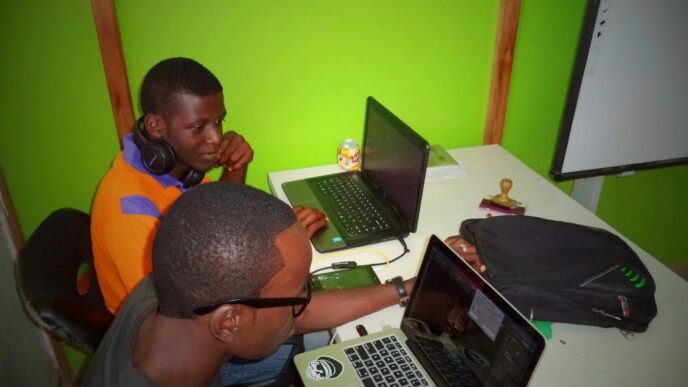The BlackCat company, also known as ALPHV or Noberus, popped up in late 2021 and quickly became a big deal in the world of cyber threats. It’s pretty unique because it’s the first ransomware built using the Rust programming language, which makes it super effective on both Windows and Linux systems. This group operates as a ransomware-as-a-service (RaaS) and has a reputation for using a ‘triple extortion’ method, hitting organizations hard. Let’s take a closer look at what makes the blackcat company tick.
Key Takeaways
- The BlackCat company uses the Rust programming language, which is pretty unusual for ransomware, making it work well on different computer systems.
- They have a ‘triple extortion’ strategy, meaning they don’t just encrypt files; they also threaten to leak data and launch other attacks if you don’t pay up.
- BlackCat operators are good at staying hidden, using clever tricks to avoid being caught by security tools and adapting their methods as they go.
- They market their services on underground forums and even run a blog to shame victims and leak their data if ransoms aren’t paid.
- The blackcat company has been involved in some big attacks, like the one on MGM Resorts, showing they can cause major problems for large organizations.
Understanding the BlackCat Company’s Origins
The Emergence of BlackCat Ransomware
Okay, so BlackCat, also known as ALPHV or Noberus, showed up around November 2021. By the end of 2022, it had already made a name for itself as a pretty sophisticated piece of malware. It’s one of those things that just seemed to pop up out of nowhere and suddenly everyone’s talking about it. They’ve been hitting targets across the globe, including places like Australia, India, and the U.S. The ransom demands? Anywhere from $400,000 to $3,000,000, usually in Bitcoin or Monero. It’s wild how much these things cost. It’s worth noting that as other ransomware platforms start to fade, some actors are moving to BlackCat.
BlackCat’s Unique Programming Language: Rust
What makes BlackCat stand out is that it’s the first big ransomware written in Rust. Rust is a programming language known for being fast and secure. It’s not your everyday language for malware, which makes BlackCat a bit different. The use of Rust allows it to work on both Linux and Windows machines, which is a big deal. It’s like they’re trying to be as versatile as possible. This cross-platform language gives them an edge.
The ALPHV Connection: A Russian-Speaking Cybercrime Outfit
ALPHV, a Russian-speaking cybercrime group, is behind BlackCat. They run it as a ransomware-as-a-service (RaaS) operation. This means they develop the ransomware and then let other criminals use it to attack targets. ALPHV is known for using a triple extortion model. This involves:
- Stealing data
- Encrypting files
- Launching denial-of-service attacks
Basically, they hit you from all angles to try and force you to pay up. They also maintain a victim blog where they post company names and leaked data if victims don’t cooperate. It’s all part of their marketing services to attract affiliates.
BlackCat Company’s Operational Modus Operandi
Initial Infection Techniques and Entry Points
BlackCat, like many ransomware groups, doesn’t rely on just one method to break into a system. They’re opportunistic, using a mix of techniques to gain that initial foothold. Current data suggests they often use third-party frameworks like Cobalt Strike, or they exploit vulnerabilities in exposed applications. Think of it like burglars checking for unlocked windows and doors, but in the digital world. They might use phishing emails to trick someone into clicking a malicious link or attachment, or they might try to brute-force their way in by guessing passwords. They also keep an eye out for known vulnerabilities, like CVEs, that they can exploit. Understanding threat actors is key to defense.
Advanced Encryption Algorithms and Strategies
Once inside, BlackCat doesn’t waste any time. They use advanced encryption algorithms to lock up your files, making them inaccessible without the decryption key. They’re not using simple, easily cracked methods; they employ robust algorithms designed to withstand brute-force attacks. They also use some advanced strategies, such as stopping virtual machines and turning off Windows Defender. The goal is to maximize the impact of the attack and minimize the chances of being stopped. The ransom amounts demanded range from $400,000 to $3,000,000 in Bitcoin or Monero.
Stealthy Communication with Command and Control Servers
After compromising a system, BlackCat needs to maintain contact with its operators. They do this through command and control (C2) servers. To keep this communication hidden, they often use reverse SSH tunnels, creating a secure and encrypted channel for sending and receiving commands. What’s interesting is that BlackCat seems to prefer human-operated command-line interfaces when interacting with these C2 servers. This allows them to adapt to the victim’s network and move laterally, targeting Active Directory user and administrator accounts with tools like PsExec. It’s like having a remote control that lets them navigate the network and escalate the damage. The Singularity Platform can help detect these infections.
BlackCat Company’s Advanced Evasion Tactics
BlackCat ransomware doesn’t just break in; it tries its best to stay hidden. They’ve put a lot of effort into making sure their presence isn’t easily detected, which makes them a particularly nasty threat. It’s like they’re playing a game of hide-and-seek, but the stakes are incredibly high.
Aggressive Discovery Evasion
BlackCat really doesn’t want to be found. One of their main strategies is to aggressively evade discovery. They do this by constantly changing their tactics and using different methods to avoid being flagged by security systems. It’s a cat-and-mouse game where they’re always trying to stay one step ahead. They might use techniques like process hollowing or memory injection to hide their malicious code within legitimate processes, making it harder to spot. They also try to delete shadow copies to prevent easy data recovery.
Recognition of Analytical Instruments
These guys are smart. BlackCat is designed to recognize when it’s being analyzed. If it detects that it’s running in a sandbox environment or being examined by security tools, it can alter its behavior or even shut down completely. This makes it much harder for researchers to understand how it works and develop effective defenses. It’s like they know when they’re being watched and put on a show to mislead the audience. This is a big problem for cybersecurity best practices because it means that traditional analysis methods might not work.
Adaptive Stealth Mechanisms
BlackCat doesn’t just have one trick up its sleeve; it has many. It uses adaptive stealth mechanisms to blend in with normal network traffic and system activity. This means it can change its communication patterns, file names, and other characteristics to avoid detection. It’s like a chameleon that can change its colors to match its surroundings. They might use techniques like encrypting their communications or using steganography to hide data within images or other files. This makes it incredibly difficult to track their activity and stop them before they can do serious damage. The ability to infect Linux and Windows gives them flexibility in terms of targets.
The BlackCat Company’s Ransom Demands and Extortion

Examining the BlackCat Ransom Note
Okay, so you’ve been hit by BlackCat. First thing you’ll probably see is the ransom note. Usually, it’s a text file named something like "RECOVER–NOTES.txt" and it’s in every folder where your files are now encrypted. What’s extra nasty is that BlackCat adds random extensions to your encrypted files, just to make things feel more personal.
The note will have a special link to a TOR website. That’s where you go to talk to the hackers and see what they want. They’ll often show some of your stolen data there as proof they’re serious. It’s all pretty grim.
Triple Extortion Model: Data Leakage, File Encryption, and DoS Attacks
BlackCat doesn’t just encrypt your files and ask for money. They go for the triple extortion. That means they hit you with three threats at once:
- They encrypt your files, so you can’t use them.
- They threaten to leak your stolen data online.
- They launch denial-of-service attacks against your systems to knock you offline.
Basically, they’re trying to squeeze you from every angle to make you pay up. They want to target many sectors, so they can get as much money as possible.
Payment Details and Associated Quandaries
BlackCat usually asks for ransom in Bitcoin or Monero, and the amount can be anywhere from $400,000 to $3,000,000. It’s a huge amount of money, and paying it is a really tough decision.
Here’s the thing: even if you pay, there’s no guarantee they’ll give you your data back or stop the attacks. Plus, paying ransomware groups can encourage them to keep doing what they’re doing. It’s a real ethical and legal mess. Some victims are pressured to pay the ransom, because of the U.S. Securities and Exchange Commission’s (SEC) rule that requires data disclosure on a specific form (1.05 of Form 8-K) within four business days after a cyberattack. It’s a tough spot to be in, no doubt about it.
Notable BlackCat Company Ransomware Attacks

The Florida Circuit Court Breach
The Florida Circuit Court experienced a significant breach, marking a bold move by the BlackCat group. This attack disrupted essential judicial processes and exposed sensitive client information. It really showed how far they were willing to go, targeting even state organizations. It’s not every day you see a court system brought to its knees by ransomware. The fallout was pretty intense, with delays in court proceedings and a scramble to secure the compromised data. It made everyone rethink cybersecurity in the legal sector.
The MGM Resorts Shutdown
MGM Resorts, a major player in the entertainment and hospitality industry, faced a complete shutdown due to a BlackCat ransomware attack. This incident highlighted BlackCat’s broad reach across different sectors. The attack severely impacted MGM’s ability to serve its customers, leading to canceled reservations, gaming disruptions, and overall chaos. It wasn’t just a minor inconvenience; it was a full-blown crisis. The financial hit was substantial, and the reputational damage was something they had to work hard to recover from. It’s a stark reminder that even the biggest companies aren’t immune to these kinds of attacks. You can read more about ransomware attacks on large corporations online.
Financial and Reputational Impact on Affected Organizations
The aftermath of BlackCat attacks is brutal for affected organizations. Operations grind to a halt, leading to lost productivity, downtime, and damage to brand reputation. The financial losses can be staggering, including recovery costs, ransom payments (if made), and legal fees. Reputational damage is another big concern. Customers lose trust, and it can take years to rebuild that confidence. Plus, there’s the risk of regulatory fines and lawsuits. It’s a perfect storm of bad news. Here’s a quick look at some common impacts:
- Operational Disruptions: Significant downtime and delays.
- Financial Losses: Recovery expenses and potential ransom payments.
- Reputational Damage: Loss of customer trust and brand value.
BlackCat Company’s Affiliate Program and Marketing
Marketing Services in Underground Forums
So, BlackCat, like other ransomware groups, isn’t just about the tech; it’s also about the business. To get their ransomware out there and used, they actively market their services on underground forums. Think of it like a really shady franchise operation. They need people to deploy their ransomware, so they advertise and recruit on these forums. This helps them expand their reach without having to do all the dirty work themselves. It’s a pretty standard practice in the ransomware world, but it’s still wild to think about.
Maintaining a Victim Blog for Data Leaks
One of the nastier aspects of the BlackCat operation is their victim blog. It’s basically a public shaming site where they post data stolen from companies that refuse to pay the ransom. It’s a form of triple extortion, adding extra pressure on victims to give in. The blog includes company names and sensitive data, making it a real nightmare for the affected organizations. It’s a brutal tactic, but it’s effective in getting victims to pay up. It’s a way to show potential affiliates that they mean business and that their data leaks are real.
Attracting Affiliates from Other Ransomware Groups
BlackCat has been pretty successful in attracting affiliates from other ransomware groups. As some of the bigger players like Ryuk and Conti have faded, BlackCat has stepped in to fill the void. They offer competitive terms and a well-developed ransomware platform, making them an attractive option for experienced cybercriminals looking for a new operation. It’s like the free agency period in sports, but for ransomware. They are marketing their marketing services to attract the best talent. This influx of experienced affiliates has helped BlackCat grow quickly and become a major threat in the ransomware landscape.
BlackCat Company’s Cross-Platform Capabilities
Support for Windows Operating Systems
BlackCat, in its quest for maximum impact, didn’t limit itself to a single operating system. It was built to run on Windows, a dominant force in the corporate world. This allowed them to target a huge number of businesses and organizations. The ransomware is able to execute commands via the Windows Command Line Interface (CLI) using WMIC.exe and cmd.exe, modifying system settings and deleting shadow copies for good measure. This makes recovery much harder, which is exactly what they want.
Support for Linux Operating Systems
But Windows wasn’t enough. BlackCat also targeted Linux systems. This is a smart move because a lot of servers and critical infrastructure run on Linux. By being able to infect both Windows and Linux, BlackCat significantly increased its reach and potential damage. The Singularity Platform is capable of detecting and preventing BlackCat infections on both Windows and Linux endpoints.
Platform Agnostic Targeting
BlackCat’s ability to work on both Windows and Linux shows they’re serious about hitting as many targets as possible. This "platform agnostic" approach means they can go after a wider range of victims, regardless of what operating system they use. This flexibility is a key part of what makes them so dangerous. They aren’t picky; they’ll go after anyone, anywhere. This is achieved by marketing services in underground forums.
Here’s a quick rundown of why this matters:
- Wider Target Range: More potential victims.
- Increased Impact: Can disrupt more systems.
- Greater Flexibility: Adapts to different environments.
Conclusion
So, what’s the takeaway here? BlackCat, even though it hasn’t been around forever, has really made a name for itself among ransomware groups. These folks know their stuff, and they’re pretty careful about who they work with. It’s possible that as some of the bigger ransomware players fade away, more bad actors are moving over to BlackCat. The people using BlackCat are good at picking their targets and try to get into systems without anyone noticing. That’s why having good, up-to-date security on your computers is super important. Tools like the SentinelOne Singularity Platform can help find and stop BlackCat infections on both Windows and Linux systems.
Frequently Asked Questions
What exactly is BlackCat Company?
BlackCat is a dangerous type of computer virus that locks up your files and demands money to unlock them. It first appeared in late 2021 and quickly became known as one of the most advanced viruses out there.
What makes BlackCat different from other computer viruses?
BlackCat is special because it’s built using a programming language called Rust. This makes it very powerful and able to attack both Windows and Linux computers. It’s also run by a Russian-speaking cybercrime group called ALPHV.
How does BlackCat get onto computers?
BlackCat tries to get into computers through things like tricky emails that make you click on bad links or open harmful files. It also looks for weaknesses in computer programs that haven’t been updated.
What does BlackCat do once it’s inside a computer system?
Once it’s in, BlackCat uses strong methods to scramble your files so you can’t open them. It also talks to its operators secretly to get commands and spread further through a computer network.
What is ‘triple extortion’ in the context of BlackCat?
BlackCat uses a ‘triple extortion’ method. This means they might threaten to leak your private information, encrypt your files so you can’t use them, and even try to shut down your computer systems completely if you don’t pay the ransom.
Have there been any major attacks by BlackCat?
BlackCat has been involved in some big attacks, like the one on the Florida Circuit Court and the shutdown of MGM Resorts. These attacks caused major problems and showed how serious BlackCat’s threats are.














